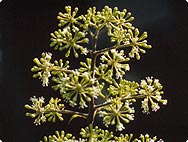A.Vogel search
When the internal search is activated, personal data such as your IP address is transmitted to our search engine Cludo. Data is thus transferred to a third country. Please click here if you want to display the internal search. You can find more information on data protection here: Privacy policy.
A.Vogel plant encyclopaedia
Aralia racemosa L.
American Spikenard
History

In its North American habitat the aralia root was used by herbalists and eclectics as a medicine for lung infections such as coughs, catarrh and tuberculosis as well as gynaecological disorders such as leucorrhoea, prolapse of the uterus and chlorosis. It was regarded as a diaphoretic, antirheumatic, stomachic and expectorant.
In 1867, Hale adopted the plant from American eclectics for use in homeopathy. Aralia racemosa originates from the Latin word racemus, meaning «cluster» and refers to its clusters of flowers.
Botanical characteristics

American spikenard has a thick, tuberous, whitish yellow branching rhizome which is fragrant and whose spongy tissue contains a yellow coloured latex. This rhizome produces a perennial herb which grows into a bush with partially lignified, grooved, sometimes tangled, brittle stems. The stalks grow to a height of up to 1,5 metres. The large, oval leaves (up to 20 cm in length) have between 3 and 5 pinnates. The small greenish white flowers grow either laterally from the axils or in spikes at the end of the plant in long, paniculated, spherical umbels. The round berries are dark red or purple in colour.
The American spikenard flowers from July to August.
In Europe ivy is the only form of Araliaceae in existence. Araliaceae are to be found in great profusion in America and Asia where they grow into thick, sometimes thorny shrubs or trees.
Habitat

Aralia racemosa originates in the wooded mountains of North America in an area extending from central Canada down to Virginia. The plant grows on rocky but highly fertile river banks.
Preparation

A.Vogel/Bioforce uses a homeopathic dilution in accordance with HAB 2000 made from fresh rhizomes originating from our own organic cultivation.
In its habitat the roots of the plant are used to prepare cough syrups, tinctures and infusions.